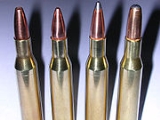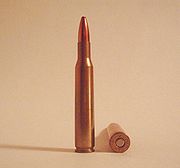
.270 Winchester
Encyclopedia
The .270 Winchester was developed by Winchester Repeating Arms Company
in 1923 and unveiled in 1925 as a chambering for their bolt-action
Model 54
. The cartridge is based upon the .30-06 Springfield
. When loaded with a bullet that expands rapidly or fragments in tissue, this cartridge delivers devastating terminal performance.
The .270 Winchester became a very popular deer and elk cartridge due to the widespread praises of gunwriter Jack O'Connor
who used the cartridge for 40 years and espoused its praise on the pages of Outdoor Life. Driving a 130 gr bullet at approximately 3140 ft/s (957 m/s), (later reduced to 3060 ft/s (933 m/s)) the cartridge demonstrated high performance at the time of its introduction and was marketed as being suitable for long range shooting (400-1000 yards) on most big game. Two additional bullet weights were soon introduced: a 100 gr hollow-point bullet for varmint shooting, and a 150 gr bullet for larger deer
, elk
and moose
in big-game hunting.
While not an immediate success, over the succeeding decades and especially in the post-World War II
period, the .270 Winchester attained great popularity among gun owners and hunters, ranking it among the most popular and widely used cartridges worldwide. Internationally, firearms manufacturers now offer this chambering in all firearm varieties: bolt-action
s, single-shot
s, lever-action
s (such as Browning BLR
), pump-action
s (such as Remington 7600
), autoloaders
(such as Remington 7400
) and even a few double rifles.
While it is true that a .270 Winchester case can be formed from a 30-06 Springfield case, the case length of a 30-06 is 2.494 inches (63.3 mm) while the case length of a .270 is 2.54 inches (64.5 mm), the same as a .30-03 Springfield
. It is recommended that .270 Winchester brass be formed from .35 Whelen
or .280 Remington
cases.

Winchester Repeating Arms Company
The Winchester Repeating Arms Company was a prominent American maker of repeating firearms, located in New Haven, Connecticut. The Winchester brand is today used under license by two subsidiaries of the Herstal Group, Fabrique Nationale of Belgium and the Browning Arms Company of Morgan, Utah.-...
in 1923 and unveiled in 1925 as a chambering for their bolt-action
Bolt-action
Bolt action is a type of firearm action in which the weapon's bolt is operated manually by the opening and closing of the breech with a small handle, most commonly placed on the right-hand side of the weapon...
Model 54
Winchester Model 54
The Winchester Model 54 is a bolt action rifle manufactured by the Winchester Repeating Arms Company. The 54 was the first successful production run centerfire bolt action for Winchester....
. The cartridge is based upon the .30-06 Springfield
.30-06 Springfield
The .30-06 Springfield cartridge or 7.62×63mm in metric notation, was introduced to the United States Army in 1906 and standardized, and was in use until the 1960s and early 1970s. It replaced the .30-03, 6 mm Lee Navy, and .30 US Army...
. When loaded with a bullet that expands rapidly or fragments in tissue, this cartridge delivers devastating terminal performance.
The .270 Winchester became a very popular deer and elk cartridge due to the widespread praises of gunwriter Jack O'Connor
Jack O'Connor (American writer)
Jack O'Connor was best known as a writer for Outdoor Life magazine, where he served as Shooting Editor for 31 years....
who used the cartridge for 40 years and espoused its praise on the pages of Outdoor Life. Driving a 130 gr bullet at approximately 3140 ft/s (957 m/s), (later reduced to 3060 ft/s (933 m/s)) the cartridge demonstrated high performance at the time of its introduction and was marketed as being suitable for long range shooting (400-1000 yards) on most big game. Two additional bullet weights were soon introduced: a 100 gr hollow-point bullet for varmint shooting, and a 150 gr bullet for larger deer
Deer
Deer are the ruminant mammals forming the family Cervidae. Species in the Cervidae family include white-tailed deer, elk, moose, red deer, reindeer, fallow deer, roe deer and chital. Male deer of all species and female reindeer grow and shed new antlers each year...
, elk
Elk
The Elk is the large deer, also called Cervus canadensis or wapiti, of North America and eastern Asia.Elk may also refer to:Other antlered mammals:...
and moose
Moose
The moose or Eurasian elk is the largest extant species in the deer family. Moose are distinguished by the palmate antlers of the males; other members of the family have antlers with a dendritic configuration...
in big-game hunting.
While not an immediate success, over the succeeding decades and especially in the post-World War II
World War II
World War II, or the Second World War , was a global conflict lasting from 1939 to 1945, involving most of the world's nations—including all of the great powers—eventually forming two opposing military alliances: the Allies and the Axis...
period, the .270 Winchester attained great popularity among gun owners and hunters, ranking it among the most popular and widely used cartridges worldwide. Internationally, firearms manufacturers now offer this chambering in all firearm varieties: bolt-action
Bolt-action
Bolt action is a type of firearm action in which the weapon's bolt is operated manually by the opening and closing of the breech with a small handle, most commonly placed on the right-hand side of the weapon...
s, single-shot
Single-shot
Single-shot firearms are firearms that hold only a single round of ammunition, and must be reloaded after each shot. The history of firearms began with single-shot designs, and many centuries passed before multi-shot designs became commonplace...
s, lever-action
Lever-action
Lever-action is a type of firearm action which uses a lever located around the trigger guard area, to load fresh cartridges into the chamber of the barrel when the lever is worked. Most lever-action firearms are rifles, but lever-action shotguns and a few pistols have also been made...
s (such as Browning BLR
Browning BLR
The Browning BLR is a lever action rifle manufactured by Browning Arms Company. It comes in many different variations and is chambered in calibers from .22-250 Remington to .325 WSM to .450 Marlin.- Differences :...
), pump-action
Pump-action
A pump-action rifle or shotgun is one in which the handgrip can be pumped back and forth in order to eject a spent round of ammunition and to chamber a fresh one. It is much faster than a bolt-action and somewhat faster than a lever-action, as it does not require the trigger hand to be removed from...
s (such as Remington 7600
Remington Model 7600 rifle
The Remington Model 7600 is a series of pump-action, centerfire rifles and carbines that are made by Remington Arms. The Model 7600 appears to be a combination of the Remington Model 7400 series semi-automatic hunting rifle with the action of the Remington Model 870 series pump-action shotgun,...
), autoloaders
Semi-automatic firearm
A semi-automatic, or self-loading firearm is a weapon which performs all steps necessary to prepare the weapon to fire again after firing—assuming cartridges remain in the weapon's feed device or magazine...
(such as Remington 7400
Remington Model 7400
The Remington Model 7400 is a series of semi-automatic, autoloading centerfire rifles and carbines that was made by Remington Arms. The Model 7400 was chambered in many calibers....
) and even a few double rifles.
Loads
Factory bullets are commonly available in 100, 110, 130, 140, 150 and 160 gr sizes with 130 and 150 gr loads being by far the most popular. Handloaders have a larger range of options with the availability of bullets in a number of weights from 90 to 180 gr. Common bullet weight recommendations for shooting different game are as follows:- 90-110 grain bullets: animals smaller than antelopePronghornThe pronghorn is a species of artiodactyl mammal endemic to interior western and central North America. Though not an antelope, it is often known colloquially in North America as the prong buck, pronghorn antelope, or simply antelope, as it closely resembles the true antelopes of the Old World and...
. - 130 grain bullets: antelope or other animals up to the size of mule deerMule DeerThe mule deer is a deer indigenous to western North America. The Mule Deer gets its name from its large mule-like ears. There are believed to be several subspecies, including the black-tailed deer...
. - 140-160 grain bullets: deerDeerDeer are the ruminant mammals forming the family Cervidae. Species in the Cervidae family include white-tailed deer, elk, moose, red deer, reindeer, fallow deer, roe deer and chital. Male deer of all species and female reindeer grow and shed new antlers each year...
, elkElkThe Elk is the large deer, also called Cervus canadensis or wapiti, of North America and eastern Asia.Elk may also refer to:Other antlered mammals:...
, mooseMooseThe moose or Eurasian elk is the largest extant species in the deer family. Moose are distinguished by the palmate antlers of the males; other members of the family have antlers with a dendritic configuration...
and some larger animals.
While it is true that a .270 Winchester case can be formed from a 30-06 Springfield case, the case length of a 30-06 is 2.494 inches (63.3 mm) while the case length of a .270 is 2.54 inches (64.5 mm), the same as a .30-03 Springfield
.30-03
The .30-03 was a short-lived cartridge developed by the United States in 1903, to replace the .30-40 Krag in the new Springfield 1903 rifle. The .30-03 was also called the .30-45, since it used a 45 grain powder charge; the name was changed to .30-03 to indicate the year of adoption. It used a...
. It is recommended that .270 Winchester brass be formed from .35 Whelen
.35 Whelen
The .35 Whelen is a powerful medium-bore rifle cartridge that does not require a magnum action or a magnum bolt-face. The parent of this cartridge is the .30-06 Springfield, which is necked-up to accept a bullet diameter of...
or .280 Remington
.280 Remington
The .280 Remington, also known as the 7 mm Express Remington, was introduced in 1957 for the Remington model 740, 760, 721 and 725 rifles. The .280 is based on the .30-06 Springfield necked down to accept 7 mm bullets, with the neck moved forward .050in...
cases.

See also
- List of rifle cartridges
- 7 mm caliber7 mm caliberThis article lists firearm cartridges which have a bullet in the to caliber range.*Length refers to the cartridge case length.*OAL refers to the overall length of the cartridge....
- .270 WSM
- sectional densitySectional densitySectional density is the ratio of an object's mass to its cross-sectional area. It conveys how well an object's mass is distributed to overcome resistance. For illustration, a needle can penetrate a target medium with less force than a coin of the same mass...
- .30-06
- .270-06.30-06 Springfield Wildcat CartridgesWildcat cartridges are firearms cartridges whose dimensions have been modified. Usually these modifications are with an eye toward improved performance, either measurable or not. This article deals with wildcat cartridges which result from a simple necking down or up of the original .30-06...

